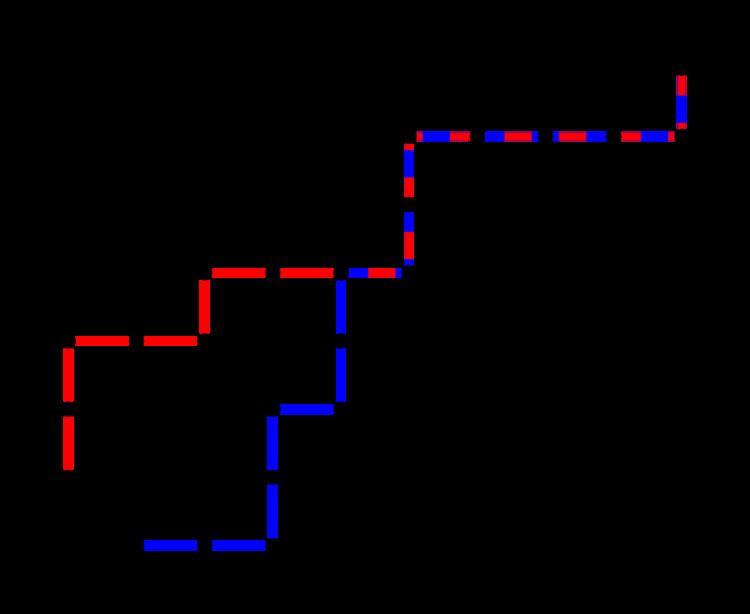 | ||
In combinatorics, Bertrand's ballot problem is the question: "In an election where candidate A receives p votes and candidate B receives q votes with p > q, what is the probability that A will be strictly ahead of B throughout the count?" The answer is
Contents
- Example
- Equivalent problems
- Proof by reflection
- Proof by induction
- Bertrands and Andrs proofs
- Variant ties allowed
- References
The result was first published by W. A. Whitworth in 1878, but is named after Joseph Louis François Bertrand who rediscovered it in 1887.
In Bertrand's original paper, he sketches a proof based on a general formula for the number of favourable sequences using a recursion relation. He remarks that it seems probable that such a simple result could be proved by a more direct method. Such a proof was given by Désiré André, based on the observation that the unfavourable sequences can be divided into two equally probable cases, one of which (the case where B receives the first vote) is easily computed; he proves the equality by an explicit bijection. A variation of his method is popularly known as André's reflection method, although André did not use any reflections.
Example
Suppose there are 5 voters, of whom 3 vote for candidate A and 2 vote for candidate B (so p = 3 and q = 2). There are ten possibilities for the order of the votes cast:
For the order AABAB, the tally of the votes as the election progresses is:
For each column the tally for A is always larger than the tally for B so the A is always strictly ahead of B. For the order AABBA the tally of the votes as the election progresses is:
For this order, B is tied with A after the fourth vote, so A is not always strictly ahead of B. Of the 10 possible orders, A is always ahead of B only for AAABB and AABAB. So the probability that A will always be strictly ahead is
and this is indeed equal to
Equivalent problems
Rather than computing the probability that a random vote counting order has the desired property, one can instead compute the number of favourable counting orders, then divide by the total number of ways in which the votes could have been counted. (This is the method used by Bertrand.) The total number of ways is the binomial coefficient
Another equivalent problem is to calculate the number of random walks on the integers that consist of n steps of unit length, beginning at the origin and ending at the point m, that never become negative. Assuming n and m have the same parity and n ≥ m ≥ 0, this number is
When m = 0 and n is even, this gives the Catalan number
Proof by reflection
For A to be strictly ahead of B throughout the counting of the votes, there can be no ties. Separate the counting sequences according to the first vote. Any sequence that begins with a vote for B must reach a tie at some point, because A eventually wins. For any sequence that begins with A and reaches a tie, reflect the votes up to the point of the first tie (so any A becomes a B, and vice versa) to obtain a sequence that begins with B. Hence every sequence that begins with A and reaches a tie is in one-to-one correspondence with a sequence that begins with B, and the probability that a sequence begins with B is
Proof by induction
Another method of proof is by mathematical induction:
Bertrand's and André's proofs
Bertrand expressed the solution as
where
where
and thus the required probability is
as expected.
Variant: ties allowed
The original problem is to find the probability that the first candidate is always strictly ahead in the vote count. Consider now the problem to find the probability that the second candidate is never ahead (i.e. ties are allowed); the solution is
The variant problem can be solved by the reflection method in a similar way to the original problem. First note that the number of possible vote sequences is
Represent a voting sequence as a lattice path on the Cartesian plane as follows:
Each such path corresponds to a unique sequence of votes and will end at (p, q). A sequence is 'good' exactly when the corresponding path never goes above the diagonal line y = x; equivalently, a sequence is 'bad' exactly when the corresponding path touches the line y = x + 1.
For each 'bad' path P, define a new path P′ by reflecting the part of P up to the first point it touches the line across it. P′ is a path from (−1, 1) to (p, q). The same operation applied again restores the original P. This produces a one-to-one correspondence between the 'bad' paths and the paths from (−1, 1) to (p, q). The number of these paths is
Since there are
In fact, the solutions to the original problem and the variant problem are easily related. For candidate A to be strictly ahead throughout the vote count, they must receive the first vote and for the remaining votes (ignoring the first) they must be either strictly ahead or tied throughout the count. Hence the solution to the original problem is
as required.
Conversely, the tie case can be derived from the non-tie case. Note that the number of non-tie sequences with p+1 votes for A is equal to the number of tie sequences with p votes for A. The number of non-tie votes with p + 1 votes for A votes is
